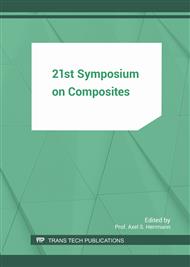p.740
p.745
p.753
p.763
p.778
p.786
p.793
p.800
p.807
Experimental Investigations on Integrated Conductor Paths in Fiber-Reinforced Thermoplastic Composite Structures
Abstract:
By the benefit of functional integration the advantages of fiber reinforced plastics (FRP) as construction material can be increased due to the possibilities of integrating sensors and actuators. In Regard to the layer-by-layer definition of the wall thickness, this class of material offers a high potential for the integration of additional smart elements within the stacking and forming process. In addition to the actual integration methods of sensors or actuators, the electrical signal transmission and contacting is of great importance for smart structures. Various approaches can be followed. On the one hand, the conductor path can be defined by means of a wire and, on the other hand, the definition of conductor paths can be accomplished by functionalized films (by means of printing technology). Within this paper, experimental investigations are intended to demonstrate the suitability of screen-printed conductor paths for the press-technical transformation of FRP structures. In addition to the variation of the screen printing material and the film material, for a material-homogeneous integration, an evaluation of a corresponding selection of materials takes place with respect to the stresses derived from the deformation-technical boundary conditions.
Info:
Periodical:
Pages:
793-799
Citation:
Online since:
July 2017
Authors:
Price:
Сopyright:
© 2017 Trans Tech Publications Ltd. All Rights Reserved
Share:
Citation:


